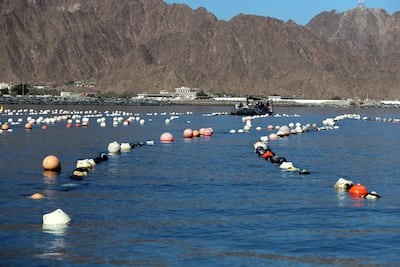A stone's throw from the Fujairah coast, millions of meaty oysters are being harvested in the Sea of Oman.
Located 500 metres offshore, Dibba Bay Oysters takes pride in being the first and only shellfish farm in the UAE that produces gourmet oysters.
Bright white and orange buoys speckled with barnacles bob in the open water and act as markers for the 3,700 square-metre aquafarm. Within the next few months, it is set to expand to 4,200 square metres.
On the day The National visited, about 10 million Pacific cupped oysters of varying sizes swayed in a series of lantern nets metres below the surface of the water.
“We have an abundance of algae bloom on site and the oysters gorge on that,” said Ramie Murray, the seafaring farmer who set up the underwater garden in 2017.
“There is so much natural food and algae in the open waters here, which makes it the perfect environment to harvest fat, juicy oysters.”
The lanterns look simple but they play an important role in the harvesting process.
The nets work to keep the oysters out of the muck so they can feed in the water column and avoid being smothered by sediment.
The extra shelter also helps keep predators such as crabs and stingrays at bay.
Typically, oysters are farmed close to shore, where there is a lot of tidal movement. Mr Murray said his stock was farmed offshore because the warmer climate made for a great harvest.
“What enables us to farm in this environment? Well, traditionally, people tend to think oysters can only be farmed in cold climates. That’s not the case,” he said.
“Generally, in cold climates, there’s an upwelling of water which brings food to the surface.
“Here, we farm a little deeper but have a good upwelling of cold water and a constant supply of natural food. Fujairah is one of few hot places with an abundant algae supply.”
Each month, about 70,000 oysters are plucked from the waters and sent to local and global markets.
By the end of 2021, Mr Murray wants to harvest up to 500,000 each month because there is high demand, especially in Russia.

Owing to the undercurrent, the layered nets, which are like mesh tubes, sit at an angle and allow food and water to pass through easily.
More than 70 workers at the farm tirelessly monitor the stock. Nearly every hour they are required to lift out and hose down the nets to ensure the oysters have a constant flow of food.
"We have 3,000 lanterns in the water and depending on the size of the oyster, each can hold a different capacity,” he said.
“When they are babies, we can fit between 5,000 and 10,000 oysters in each lantern. When they are bigger, that number drastically reduces to about 400 or 500.
“Each oyster starts and finishes its growing process on land.”
As filter feeders, a large oyster can suck in up to 170 litres of water a day. And from baby to fully grown, it takes about eight months to harvest. They can reach weights of up to 100 grams and lengths of 8 centimetres.
Mr Murray, a Scot who has been living in the UAE for more than two decades, said he bought baby oysters, which are only 2 millimetres long, from international hatcheries in places such as the UK and France.

The same species of oyster can hold a different taste and texture, depending on where they are harvested.
“That is the real beauty of this shellfish, it is totally unique. Oysters take their characteristics from their surroundings,” Mr Murray said.
“You’ll notice with our oysters they have a distinctly white shell. That is from the calcium in the water from the nearby limestone mountains.
“The algae is what gives them their taste and they are a vitamin and nutrient powerhouse.
“A big oyster can have up to 2 grams of protein in it and its full of magnesium, zinc and B vitamins, as well as some vitamin C and D.”
After passing through the offshore farm and processing platform, the oysters are cleaned and individually weighed at the onshore sorting centre before being packed and shipped.
Dibba Bay is the only oyster farm in Middle East and Mr Murray said he hoped it would one day be among the biggest in the world.
“We are one of the only farms in the world which is harvesting continuously,” he said.
“We harvest twice a week, every week, throughout the whole year.
“Shellfish farming is one of the only environmentally positive forms of aquaculture because we create environments.
“The hanging lanterns are like a hanging reef, so all the seaweed and food grows on the outside and all the baby fish can hide in the baskets from predators.
“We are also totally organic and only use saltwater to clean the oysters and lanterns.”





















